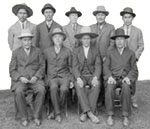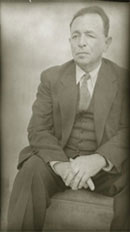|
|
|
Barbeau's StoryThe Ethnologist (2)One of my best informants was James Logan, head chief of the Cayuga nation. I actually recorded nearly eighty songs with him. In 1912, I went back for four months again. My next opportunity was a most welcome one: a delegation of ten to fifteen Indian Chiefs from western Alberta, the Rocky Mountains and the Salish area of the Fraser River and the Thompson River came to Ottawa to interview the government in connection with their land question. While here, they had plenty of leisure. I thought, "Why not collect songs with them since they are here?" I had them sing some of their songs and I was enraptured over the quality. I collected, in the space of three weeks, something like sixty or seventy songs. Tetlenitsa was the best singer and the best informed Indian among them, and very sympathetic. We worked together and I had great difficulty in recording those harsh sounds, sounds of the palate, of the throat, throat-rattling we call that, and so forth. It was very difficult, but I managed to do it and I kept on recording. I transcribed several of them and I think I wrote good transcriptions. Tetlenitsa has always remained a figure in my own experience with the Indians. He was an old man of the Thompson River, Ntlakapamuks they call it. He told me a story of his going to the mountains when he was young to have a vision. He was in the mountains for a while, when one morning he was singing a song, the Song of the Bears, and suddenly he saw snow falling at a distance, and he saw two female bears coming towards him. He fell on his back and then he heard them sing a song, the song of his vision, which he sang here. We have it on record, an impressive song. He told me "I will give you the story of my vision. A thing never done. A man who has a vision should never tell it or he loses it. But", he said, " when I die, I'll inform you wherever you are." Fifteen or twenty years later, I was on the Skeena River working with the Tsimshian, an entirely different group of people way up towards Alaska. One night, I was coming back home when there was a man that walked on the track back and forth, and he said: "Are you M. Barbeau?" I said, "Yes I am, why?" He said, "You know you have a friend way down in the Ntlakapamuks territory. He has died and he wants me to tell you, and here you know." It's easy to make friends with the Indians, especially when you work with them and get their story. The Tsimshian and others, when you work with them as I have, one tribe after another, one family after another, they know that I'm recording their own story. I'm interested in what they think, in their own happiness, in their dirge songs, in their morality, in their art, in their carving. When they know that, you are one with them. In fact, I am the recorder of Tsimshian history, in particular where I've been eight long seasons among them and I practically studied every family. (Barbeau was helped in that by an interpreter and close collaborator, Mr. William Beynon, with whom he worked closely for over 40 years.) In 1949, we proceeded to Oshwegan, a little village in the centre of Grand River Reserve, near Hamilton. There I began with Charles Cook as an interpreter. We began to study the dialects, the phonetics with old chiefs there. We spent three seasons altogether, making a fairly complete survey of the dialects, in the form of a dictionary which I have prepared. When at Grand River, we decided to collect Iroquois songs of the White Dog festival, and we collected a number of Indian songs there which form a fine repertory. The Canadian Museum of Civilization is in partnership with the Marius Barbeau Documentation Center. |
Bibliography · Links · Credits · Index




